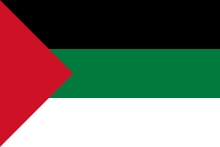| Revision as of 08:18, 14 May 2008 editCausteau (talk | contribs)3,519 editsm rv; Somaliland is not recognized as a sovereign nation by any country or international organization; it is officially recognized as a region of Somalia and therefore shouldn't be listed here← Previous edit | Revision as of 19:00, 14 May 2008 edit undoKoavf (talk | contribs)Extended confirmed users2,174,994 edits Undid revision 212306904 by Causteau (talk) Rv. this page is not just for sovereign states - where did you get that idea?Next edit → | ||
| Line 1: | Line 1: | ||
| ] | ] | ||
| The '''Pan-Arab colors''' are ], ], ], and ] and have their origins in the ]. The first three colors are featured in the flags of ] and ]; together with green they are also on the flags of ], ], ], ], ], ], the ], and ]. | The '''Pan-Arab colors''' are ], ], ], and ] and have their origins in the ]. The first three colors are featured in the flags of ] and ]; together with green they are also on the flags of ], ], ], ], ], ], ], the ], and ]. | ||
| It is believed that each color of the 4 Pan-Arab Colors represent a certain Arab Dynasty or era: the Black was the color of the flag of the ] ], while white was taken by the ]s to be their Symbol, as a reminder of the ], Green was taken by the ] to symbolize their support to ], while red was the flag held by the ], and then became the symbol of rulers in ] and ]. | It is believed that each color of the 4 Pan-Arab Colors represent a certain Arab Dynasty or era: the Black was the color of the flag of the ] ], while white was taken by the ]s to be their Symbol, as a reminder of the ], Green was taken by the ] to symbolize their support to ], while red was the flag held by the ], and then became the symbol of rulers in ] and ]. | ||
| Line 16: | Line 16: | ||
| Image:Flag of Kuwait.svg|<center>]</center> | Image:Flag of Kuwait.svg|<center>]</center> | ||
| Image:Flag of Palestine.svg|<center>]</center> | Image:Flag of Palestine.svg|<center>]</center> | ||
| Image:Flag of Somaliland.svg|<center>]</center> | |||
| Image:Flag of Sudan.svg|<center>]</center> | Image:Flag of Sudan.svg|<center>]</center> | ||
| Image:Flag of Syria.svg|<center>]</center> | Image:Flag of Syria.svg|<center>]</center> | ||
Revision as of 19:00, 14 May 2008

The Pan-Arab colors are red, black, white, and green and have their origins in the flag of the Arab Revolt. The first three colors are featured in the flags of Egypt and Yemen; together with green they are also on the flags of Iraq, Jordan, Kuwait, Palestinians, Somaliland, Sudan, Syria, the United Arab Emirates, and Sahrawi Arab Democratic Republic.
It is believed that each color of the 4 Pan-Arab Colors represent a certain Arab Dynasty or era: the Black was the color of the flag of the Islamic prophet Muhammad, while white was taken by the Umayyads to be their Symbol, as a reminder of the Battle of Badr, Green was taken by the Fatimids to symbolize their support to Ali Bin Abi Talib, while red was the flag held by the Khawarij, and then became the symbol of rulers in North Africa and Al-Andalus.
Other Arab countries, while not using all of the Pan-Arab colors, do use some of them in other combinations: Algeria and Lebanon, for example, use green, white and red, and no black.
Current flags with Pan-Arab colors
-
Ahwaz
Ahwaz -

Egypt -

Iraq -

Jordan -

Kuwait -

Palestine -

Somaliland -

Sudan -

Syria -

United Arab Emirates -

Sahrawi Arab Democratic Republic -

Yemen
Former flags with the Pan-Arab colors
-

The Federation of Arab Republics (Egypt (1972–1984), Syria (1972–1980), and Libya (1972–1977)) -

Libya (1951–1969) -

Libya (1969–1972) -

Kingdom of Iraq (1921–1959) -

Iraq (1959–1963) -

Iraq (1963–1991) and Syria (1963–1972) -

Iraq (1991–2004) -

Syria (1932–1958 and 1961–1963) -

United Arab Republic (1958–1961) -

Yemen Arab Republic (1962–1990) -

People's Democratic Republic of Yemen (1945–1990)